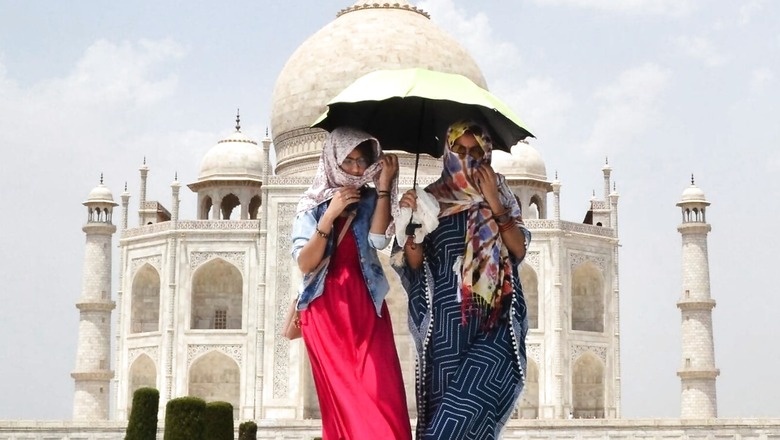
views
Even as the Northwest and Central India continue to remain under the grip of an intense heatwave, with day temperatures hovering around 43-45℃ across most states and the weatherman further stepping up the warnings, two fresh western disturbances are likely to bring slight respite in early May, according to the latest forecast of the India Meteorological Department.
On Friday, an orange alert was sounded for Punjab, Haryana, Delhi, Rajasthan, West Uttar Pradesh, Madhya Pradesh, Jharkhand and Vidarbha region for the next three days, with the IMD calling upon the local administration to take preventive action.
Gurgaon has already breached the record for the hottest day for April after the mercury crossed 45.6℃ on Thursday.
The national capital’s Safdarjung Laboratory recorded a temperature of 43.5℃, this month’s highest, while several other weather stations, including the ones in Ridge, Sports Complex, Najafgarh, witnessed temperatures way above normal.
THE WESTERN DISTURBANCES
“There are feeble chances of isolated rain over the northern plains, but the dust storms and gusty winds are expected to prevent the temperatures from rising further. After a rise of 1-2℃ over the next few days, the temperatures may stabilise,” said Charan Singh, senior meteorologist at Regional Meteorological Centre, New Delhi.
According to the forecast, a western disturbance has already hit the upper Himalayan region, and light moderate rainfall is expected over the Jammu-Kashmir-Ladakh-Gilgit-Baltistan-Muzaffarabad stretch during the next two days and Himachal Pradesh and Uttarakhand over the next five days.
The northern plains of Punjab, Haryana-Chandigarh-Delhi, Uttar Pradesh and Rajasthan could witness dust storms, which may help in abating the current heatwave conditions.
Another fresh western disturbance is expected around May 2, which is also likely to bring isolated light and scattered rainfall over some parts of the northwest India and dust storms on May 3-4, IMD said.
WHO SO HOT?
The absence of rainfall in March and April has aggravated the summer woes for Northwest India. After a record-breaking heatwave in March, there is a staggering deficit of 87% in the seasonal rainfall from March 1 till date, while the deficit stands at 70% for Central India.
It may be too early to say, but the summer of 2022 could turn out to be the hottest in recent years if the current atmospheric conditions continue to prevail. Interestingly, the heatwaves have persisted this season despite cooler water temperatures being recorded over the sea-surface in the equatorial Pacific region – a condition called La Nina. This ocean phenomenon is also associated with cooler weather over the subcontinent and a favourable southwest monsoon.
This is in stark contrast to 2015 – an El Nino year, when India, along with its neighbouring countries, bore the brunt of a devastating heatwave. India alone is recorded to have lost 2,081 lives in the heatwaves that year.
“Relatively normal or lower than normal temperatures are seen during La Nina, but that is not the situation this year. While global warming brings an incremental change in the temperature every year, various other drivers influence local weather. This year, we have seen that those atmospheric variations have dominated short-term compared to La Nina. We are seeing weather patterns that are consistently bringing warm winds from Thar Desert. Then there are clear skies and very few active western disturbances, which is leading to higher temperatures,” said D S Pai, senior meteorologist and the director of Institute of Climate Change Studies.
PUBLIC HEALTH HAZARD
According to the World Meteorological Organisation (WMO), under the intensifying impacts of climate change, heatwaves have been among the deadliest weather hazard in recent years.
India lost 3,176 lives in heatwaves from 2015 to 2018, according to the ministry of earth sciences. While the fatality rate is believed to have come down in the following years, public health experts say the risks remain high.
“This year, the heat has been extremely disturbing, mostly because it arrived earlier than usual. There were heatwaves in March, and this is more dangerous in terms of public health, because it leaves little time for people to adapt to the harsh weather conditions. It is why it becomes more urgent than ever to step up awareness for heat-related action, as it is a major risk and can affect anyone. We can’t dwell on the perception that heatwave is common in India. They are as serious as any other natural disaster that impacts the country,” said Abhiyant Tiwari, Program Manager at the Gujarat Institute of Disaster Management, Gandhinagar, who has been working to scale up heatwave action plans in the country.
Read all the Latest India News here

















Comments
0 comment